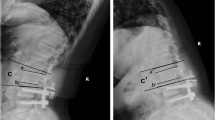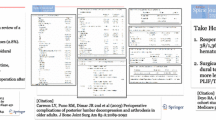Abstract
Purpose
Adjacent segment disease (ASD) is an increasing problematic complication following lumbar fusion surgeries. ASD requires appropriate treatment, although there are only few reports on surgery for ASD. This study aimed to clarify surgical outcomes of posterior lumbar interbody fusion (PLIF) for ASD.
Methods
Medical charts of 18 patients who underwent the second (repeat) PLIF for ASD were retrospectively investigated (average follow-up, 40 [27–66] months). Modified Japanese Orthopaedic Association (JOA) score and Whitecloud classification were used as outcome measures.
Results
Mean modified JOA score improved from 7.7 just before repeat PLIF to 11.4 at maximum recovery and declined to 10.2 at final follow-up. Mean recovery rate of modified JOA score was 52.9 % at maximum recovery and 31.6 % at final follow-up. According to Whitecloud classification, 17 patients (94 %) were excellent or good and only 1 was fair at maximum recovery, whereas 10 (56 %) were excellent or good, 6 were fair, and 2 were poor at final follow-up. Eight patients (44 %) deteriorated again because of recurrent ASD. Two poor patients underwent a third PLIF.
Conclusion
PLIF is effective for ASD after PLIF in the short term, although it tends to lead to a high incidence of recurrent ASD.

Similar content being viewed by others
References
Park P, Garton HJ, Gala VC, Hoff JT, McGillicuddy JE (2004) Adjacent segment disease after lumbar or lumbosacral fusion: review of the literature. Spine 29:1938–1944
Cho KS, Kang SG, Yoo DS, Huh PW, Kim DS, Lee SB (2009) Risk factors and surgical treatment for symptomatic adjacent segment degeneration after lumbar spine fusion. J Korean Neurosurg Soc 46:425–430
Sears WR, Sergides IG, Kazemi N, Smith M, White GJ, Osburg B (2011) Incidence and prevalence of surgery at segments adjacent to a previous posterior lumbar arthrodesis. Spine J 11:11–20
Ekman P, Moller H, Shalabi A, Yu YX, Hedlund R (2009) A prospective randomized study on the long-term effect of lumbar fusion on adjacent disc degeneration. Eur Spine J 18:1175–1186
Chen WJ, Lai PL, Niu CC, Chen LH, Fu TS, Wong CB (2001) Surgical treatment of adjacent instability after lumbar spine fusion. Spine 26:E519–E524
Gillet P (2003) The fate of the adjacent motion segment after lumbar fusion. J Spinal Disord Tech 16:338–345
Schlegel JD, Smith JA, Schleusener RL (1996) Lumbar motion segment pathology adjacent to thoracolumbar, lumbar, and lumbosacral fusions. Spine 21:970–981
Whitecloud TS, Davis JM, Olive PM (1994) Operative treatment of the degenerated segment adjacent to a lumbar fusion. Spine 19:531–536
Chou D, Dekutoski M, Hermsmeyer J, Norvell DC (2012) The treatment of lumbar adjacent segment pathology after a previous lumbar surgery: a systematic review. Spine 37:S180–S188
Brantigan JW, Steffee AD, Lewis ML, Quinn LM, Persenaire JM (2000) Lumbar interbody fusion using the Brantigan I/F cage for posterior lumbar interbody fusion and the variable pedicle screw placement system. Spine 25:1437–1446
Kasis AG, Marshman LAG, Krishna M, Bhatia CK (2009) Significantly improved outcomes with a less invasive posterior lumbar interbody fusion incorporating total facetectomy. Spine 34:572–577
Okuda S, Iwasaki M, Miyauchi A, Aono H, Morita M, Yamamoto T (2004) Risk factors for adjacent segment degeneration after PLIF. Spine 29:1535–1540
Anandjiwala J, Seo JY, Ha KY, Oh IS, Shin DC (2011) Adjacent segment degeneration after instrumented posterolateral lumbar fusion: a prospective cohort study with a minimum five-year follow-up. Eur Spine J 20:1951–1960
Chen BL, Wei FX, Ueyama K, Xie DH, Sannnohe A, Lui SY (2011) Adjacent segment degeneration after single-segment PLIF: the risk factor for degeneration and its impact on clinical outcomes. Eur Spine J 20:1946–1950
Lee CS, Hwang CJ, Lee SW, Ahn YJ, Kim YT, Lee DH, Lee MY (2009) Risk factors for adjacent segment disease after lumbar fusion. Eur Spine J 18:1637–1643
Phillips FM, Carlson GD, Bohlman HH, Hughes SS (2000) Results of surgery for spinal stenosis adjacent to previous lumbar fusion. J Spinal Disord 13:432–437
Pfirrmann CWA, Metzdorf A, Zanetti M, Jodler J, Boos N (2001) Magnetic resonance classification of lumbar intervertebral disc degeneration. Spine 26:1873–1878
Mura PP, Costaglioli M, Piredda M, Caboni S, Casula S (2011) TLIF for symptomatic disc degeneration: a retrospective study of 100 patients. Eur Spine J 20(suppl 1):S57–S60
Logroscino CA, Proietti L, Pola E, Scaramuzzo L, Tamburrelli FC (2011) A minimally invasive posterior lumbar interbody fusion for degenerative lumbar spine instabilities. Eur Spine J 20(suppl 1):S41–S45
Hioki A, Miyamoto K, Kodama H, Hosoe H, Hishimoto H, Sakaeda H, Simizu K (2005) Two-level posterior lumbar interbody fusion for degenerative disc disease: improved clinical outcome with restoration of lumbar lordosis. Spine J 5:600–607
Sakaura H, Yamashita T, Miwa T, Suzuki S, Ohzono K, Ohwada T (2011) Clinical outcome of two-level posterior lumbar interbody fusion for two-level degenerative lumbar spondylolisthesis. J Spine Res 3:741 (in Japanese)
Deyo RA, Martin BI, Kreuter W, Jarvik JG, Angier H, Mirza SK (2011) Revision surgery following operation for lumbar stenosis. J Bone Joint Surg Am 93:1979–1986
Shoji H, Yamazaki A, Katsumi K, Ohashi M, Suhara Y, Sato Y (2011) Operative treatment of adjacent segment disease after lumbar spinal fusion–comparison between decompression and fusion. In: Proceedings for annual meeting of Japanese spinal instrumentation society, 141
Fan SW, Hu Z, Zhao F, Zhao X, Huang Y, Fang X (2010) Multifidus muscle changes and clinical effects of one-level posterior lumbar interbody fusion: minimally invasive procedure versus conventional open approach. Eur Spine J 19:316–324
Morishita Y, Ohta H, Naito M, Matsumoto Y, Huang G, Tatsumi M, Takemitsu Y, Kida H (2011) Kinematic evaluation of the adjacent segments after lumbar instrumented surgery: a comparison between rigid fusion and dynamic non-fusion stabilization. Eur Spine J 20:1480–1485
Conflict of interest
None.
Author information
Authors and Affiliations
Corresponding author
Rights and permissions
About this article
Cite this article
Miwa, T., Sakaura, H., Yamashita, T. et al. Surgical outcomes of additional posterior lumbar interbody fusion for adjacent segment disease after single-level posterior lumbar interbody fusion. Eur Spine J 22, 2864–2868 (2013). https://doi.org/10.1007/s00586-013-2863-9
Received:
Revised:
Accepted:
Published:
Issue Date:
DOI: https://doi.org/10.1007/s00586-013-2863-9




